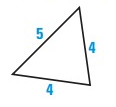CONVERSE OF THE PYTHAGOREAN THEOREM FOR CLASSIFYING TRIANGLE
Subscribe to our ▶️ YouTube channel 🔴 for the latest videos, updates, and tips.
Let a, b and c be the sides of the triangle.
- If a2 + b2 > c2, the triangle is acute triangle.
- If a2 + b2 = c2, the triangle is right triangle.
- If a2 + b2 < c2, the triangle is obtuse triangle.
Where a and b are the lengths of the two shorter sides and c be the length of the longest side.
Classify the triangle as acute, right, or obtuse, explain.
Problem 1 :

Solution:
Let c represent the length of the longest side of the triangle.
c2 ? a2 + b2
62 ? 52 + 22
36 ? 25 + 4
36 > 29
Because c2 is greater than a2 + b2, the triangle is obtuse.
Problem 2 :

Solution:
Let c represent the length of the longest side of the triangle.
c2 ? a2 + b2
172 ? 82 + 152
289 ? 64 + 225
289 = 289
Because c2 is equal to a2 + b2, the triangle is right.
Problem 3 :

Solution:
Let c represent the length of the longest side of the triangle.
c2 ? a2 + b2
72 ? 72 + 72
49 ? 49 + 49
49 < 98
Because c2 is less than a2 + b2, the triangle is acute.
Use the side lengths to classify the triangle as acute, right, or obtuse.
Problem 4 :
7, 24, 24
Solution:
By Triangle Inequality Theorem, the above set of numbers can represent the side lengths of a triangle.
Compare the square of the length of the longest side with the sum of the squares of the lengths of the two shorter sides.
c2 ? a2 + b2
242 ? 72 + 242
576 ? 49 + 576
576 < 625
Because c2 is less than a2 + b2, the triangle is acute.
Problem 6 :
7, 24, 25
Solution:
By Triangle Inequality Theorem, the above set of numbers can represent the side lengths of a triangle.
Compare the square of the length of the longest side with the sum of the squares of the lengths of the two shorter sides.
c2 ? a2 + b2
252 ? 72 + 242
625 ? 49 + 576
625 = 625
Because c2 is equal to a2 + b2, the triangle is right.
Problem 7 :
7, 24, 26
Solution:
By Triangle Inequality Theorem, the above set of numbers can represent the side lengths of a triangle.
Compare the square of the length of the longest side with the sum of the squares of the lengths of the two shorter sides.
c2 ? a2 + b2
262 ? 72 + 242
676 ? 49 + 576
676 > 625
Because c2 is greater than a2 + b2, the triangle is obtuse.
Determine whether the triangle is acute, right, or obtuse.
Problem 8 :

Solution:
Let c represent the length of the longest side of the triangle.
c2 ? a2 + b2
52 ? 42 + 42
25 ? 16 + 16
25 < 32
Because c2 is less than a2 + b2, the triangle is acute.
Problem 9 :

Solution:
Let c represent the length of the longest side of the triangle.
c2 ? a2 + b2
142 ? 122 + 62
196 ? 144 + 36
196 > 180
Because c2 is greater than a2 + b2, the triangle is obtuse.
Problem 10 :

Solution :
Let c represent the length of the longest side of the triangle.
c2 ? a2 + b2
152 ? 122 + 92
225 ? 144 + 81
225 = 225
Because c2 is equal to a2 + b2, the triangle is right.
Problem 11 :
Match the side lengths of a triangle with the best description.
|
1) 2, 10, 11 2) 8, 5, 7 3) 5, 5, 5 4) 6, 8, 10 |
A. right B. acute C. obtuse D. equiangular |
Solution:
1) By Pythagorean Theorem,
112 = 22 + 102
121 = 4 + 100
121 > 104
It is obtuse triangle.
2) By Pythagorean Theorem,
72 = 82 + 52
49 = 64 + 25
49 < 89
It is acute triangle.
3)
5, 5, 5
It is equiangular triangle.
4) By Pythagorean Theorem,
102 = 62 + 82
100 = 36 + 64
100 = 100
It is right triangle.
|
1) 2, 10, 11 2) 8, 5, 7 3) 5, 5, 5 4) 6, 8, 10 |
C. obtuse B. acute D. equiangular A. right |
Subscribe to our ▶️ YouTube channel 🔴 for the latest videos, updates, and tips.
Recent Articles
-
Finding Range of Values Inequality Problems
May 21, 24 08:51 PM
Finding Range of Values Inequality Problems -
Solving Two Step Inequality Word Problems
May 21, 24 08:51 AM
Solving Two Step Inequality Word Problems -
Exponential Function Context and Data Modeling
May 20, 24 10:45 PM
Exponential Function Context and Data Modeling